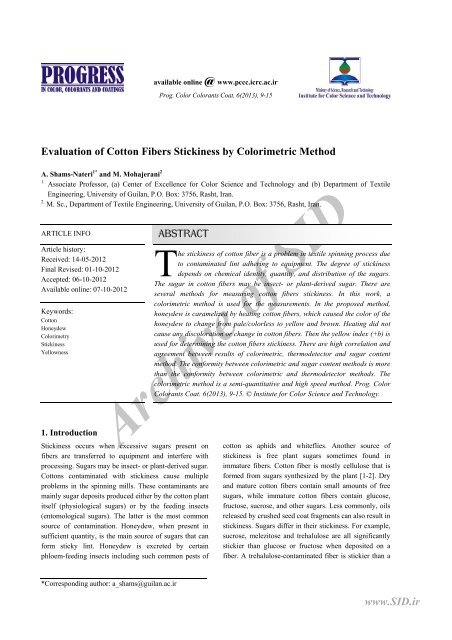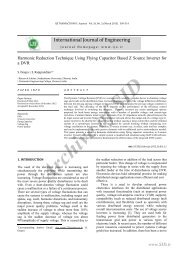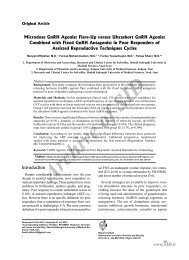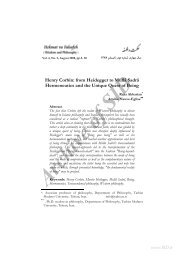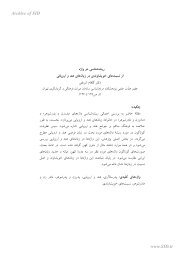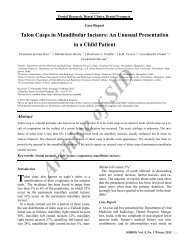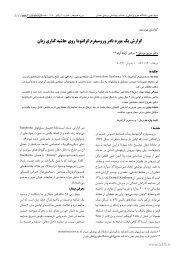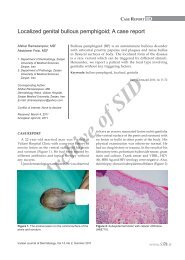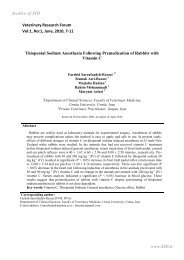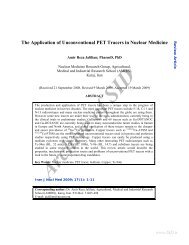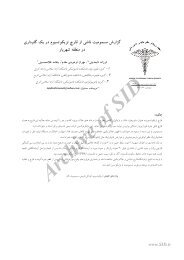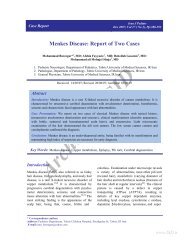Evaluation of Cotton Fibers Stickiness by Colorimetric Method
Evaluation of Cotton Fibers Stickiness by Colorimetric Method
Evaluation of Cotton Fibers Stickiness by Colorimetric Method
Create successful ePaper yourself
Turn your PDF publications into a flip-book with our unique Google optimized e-Paper software.
available online @ www.pccc.icrc.ac.ir<br />
Prog. Color Colorants Coat. 6(2013), 9-15<br />
<strong>Evaluation</strong> <strong>of</strong> <strong>Cotton</strong> <strong>Fibers</strong> <strong>Stickiness</strong> <strong>by</strong> <strong>Colorimetric</strong> <strong>Method</strong><br />
A. Shams-Nateri 1* and M. Mohajerani 2<br />
1.<br />
Associate Pr<strong>of</strong>essor, (a) Center <strong>of</strong> Excellence for Color Science and Technology and (b) Department <strong>of</strong> Textile<br />
Engineering, University <strong>of</strong> Guilan, P.O. Box: 3756, Rasht, Iran.<br />
2. M. Sc., Department <strong>of</strong> Textile Engineering, University <strong>of</strong> Guilan, P.O. Box: 3756, Rasht, Iran.<br />
ARTICLE INFO<br />
Article history:<br />
Received: 14-05-2012<br />
Final Revised: 01-10-2012<br />
Accepted: 06-10-2012<br />
Available online: 07-10-2012<br />
Keywords:<br />
<strong>Cotton</strong><br />
Honeydew<br />
Colorimetry<br />
<strong>Stickiness</strong><br />
Yellowness<br />
ABSTRACT<br />
1. Introduction<br />
<strong>Stickiness</strong> occurs when excessive sugars present on<br />
fibers are transferred to equipment and interfere with<br />
processing. Sugars may be insect- or plant-derived sugar.<br />
<strong>Cotton</strong>s contaminated with stickiness cause multiple<br />
problems in the spinning mills. These contaminants are<br />
mainly sugar deposits produced either <strong>by</strong> the cotton plant<br />
itself (physiological sugars) or <strong>by</strong> the feeding insects<br />
(entomological sugars). The latter is the most common<br />
source <strong>of</strong> contamination. Honeydew, when present in<br />
sufficient quantity, is the main source <strong>of</strong> sugars that can<br />
form sticky lint. Honeydew is excreted <strong>by</strong> certain<br />
phloem-feeding insects including such common pests <strong>of</strong><br />
T<br />
he stickiness <strong>of</strong> cotton fiber is a problem in textile spinning process due<br />
to contaminated lint adhering to equipment. The degree <strong>of</strong> stickiness<br />
depends on chemical identity, quantity, and distribution <strong>of</strong> the sugars.<br />
The sugar in cotton fibers may be insect- or plant-derived sugar. There are<br />
several methods for measuring cotton fibers stickiness. In this work, a<br />
colorimetric method is used for the measurements. In the proposed method,<br />
honeydew is caramelized <strong>by</strong> heating cotton fibers, which caused the color <strong>of</strong> the<br />
honeydew to change from pale/colorless to yellow and brown. Heating did not<br />
cause any discoloration or change in cotton fibers. Then the yellow index (+b) is<br />
used for determining the cotton fibers stickiness. There are high correlation and<br />
agreement between results <strong>of</strong> colorimetric, thermodetector and sugar content<br />
method. The conformity between colorimetric and sugar content methods is more<br />
than the conformity between colorimetric and thermodetector methods. The<br />
colorimetric method is a semi-quantitative and high speed method. Prog. Color<br />
Colorants Coat. 6(2013), 9-15. © Institute for Color Science and Technology.<br />
Archive <strong>of</strong> SID<br />
cotton as aphids and whiteflies. Another source <strong>of</strong><br />
stickiness is free plant sugars sometimes found in<br />
immature fibers. <strong>Cotton</strong> fiber is mostly cellulose that is<br />
formed from sugars synthesized <strong>by</strong> the plant [1-2]. Dry<br />
and mature cotton fibers contain small amounts <strong>of</strong> free<br />
sugars, while immature cotton fibers contain glucose,<br />
fructose, sucrose, and other sugars. Less commonly, oils<br />
released <strong>by</strong> crushed seed coat fragments can also result in<br />
stickiness. Sugars differ in their stickiness. For example,<br />
sucrose, melezitose and trehalulose are all significantly<br />
stickier than glucose or fructose when deposited on a<br />
fiber. A trehalulose-contaminated fiber is stickier than a<br />
*Corresponding author: a_shams@guilan.ac.ir<br />
www.SID.ir
Shams-Nateri and Mohajerani<br />
fiber with an equivalent amount <strong>of</strong> melezitose [1-2].<br />
Mixtures <strong>of</strong> sugars, which occur in honeydew, tend to<br />
be stickier than single sugars. Locally concentrated<br />
sugars, like honeydew, is at higher risk <strong>of</strong> causing<br />
stickiness that more evenly distributed plant sugars [1-2].<br />
Sticky cotton can reduce cotton gin output <strong>by</strong> up to<br />
25%. At a textile mill, excessive wear and increased<br />
maintenance <strong>of</strong> machinery may occur even when using<br />
slightly sticky cotton. In severe instances, mill shutdown<br />
with a thorough cleanup is required [3-4].<br />
Once cotton has been identified as being sticky, there<br />
are few reliable and cost effective methods available for<br />
remediation. The most widely utilized method involves<br />
blending sticky bales with non-sticky bales in a ratio <strong>of</strong><br />
1:10. Blending can be successful when a small number <strong>of</strong><br />
bales have been identified as being sticky. One approach<br />
to reduce the amount <strong>of</strong> sugar on the surface <strong>of</strong> cotton<br />
lint involves promoting microbiological activity on the<br />
fibers. Under suitable conditions <strong>of</strong> temperature and<br />
moisture, fungal species will grow naturally on cotton<br />
consuming the sugars present on the fiber surface. A<br />
deleterious side effect <strong>of</strong> this growth is concomitant<br />
degradation <strong>of</strong> fiber components, including cellulose and<br />
pectin, which leads to an unacceptable reduction in fiber<br />
quality. A second approach involves the utilization <strong>of</strong><br />
enzymes such as α-glycosidase to promote hydrolysis <strong>of</strong><br />
honeydew oligosaccharides to constituent glucose and<br />
fructose monomers.<br />
For the sufficient enzyme activity, the moisture in<br />
cotton fibers should be 9% or higher. Furthermore, the<br />
glucose and fructose result from enzymatic hydrolysis.<br />
Subsequent reduction <strong>of</strong> glucose and fructose levels<br />
currently depends on microbial activity and its associated<br />
detrimental effects [3-8].<br />
<strong>Stickiness</strong> from insect contamination has become a<br />
worldwide problem for cotton. The degree <strong>of</strong> stickiness<br />
depends on chemical identity, quantity and distribution<br />
<strong>of</strong> the sugars, the ambient conditions during processing<br />
(especially humidity) and the machinery itself. <strong>Stickiness</strong><br />
is therefore difficult to measure. Test method for rapid<br />
and accurate measurements <strong>of</strong> both sugar content and<br />
cotton stickiness is needed both for defining and<br />
certifying cotton quality and for process control in<br />
ginning and textile processing. The sugar content and<br />
stickiness <strong>of</strong> cotton fibers have been measured <strong>by</strong> several<br />
methods such as reducing sugar method, high<br />
performance chromatography, minicard method, sticky<br />
cotton thermo-detector, high speed stickiness detector<br />
and fiber contamination [1, 9].<br />
In stickiness measurement method: The cotton fiber<br />
stickiness has been estimated <strong>by</strong> sticking <strong>of</strong> contaminated<br />
lint to moving parts <strong>of</strong> machine. In reducing sugar<br />
method, reducing-sugar tests based on reduction <strong>of</strong> the<br />
cupric ion has been used to screen for sugar<br />
contamination. This method is relatively quick and<br />
inexpensive. In HPLC method, the High Performance<br />
Liquid Chromatography (HPLC) is used to measure both<br />
the reducing and the nonreducing sugars in honeydew. In<br />
minicard method, several types <strong>of</strong> machines are used to<br />
measure the physical interaction <strong>of</strong> all sugars on lint with<br />
equipment. One <strong>of</strong> the methods used in this test is<br />
minicard. This method has been replaced as the<br />
international standard <strong>by</strong> the manual thermodetector. The<br />
SCT (Sticky <strong>Cotton</strong> Thermodetector) method measures<br />
the physical sticking points transferred to aluminum<br />
sheets <strong>by</strong> a conditioned lint sample that is squeezed and<br />
heated. The H2SD (High speed stickiness detector)<br />
method is a quicker, automatic version <strong>of</strong> the<br />
thermodetector. In this method, cotton fiber is pressed<br />
between a heated and an unheated pressure plate. Sticky<br />
points are counted and point size distribution is<br />
determined <strong>by</strong> a computer image processing s<strong>of</strong>tware. In<br />
FCT (the Fiber Contamination Tester), a thin web is fed<br />
between two rollers. Then, contamination <strong>of</strong> the rollers<br />
interrupts a laser beam, resulting in a recording [1, 8, 9].<br />
The effect <strong>of</strong> heating has been examined previously<br />
as a method for detecting sugars on cotton lint. This<br />
method consists <strong>of</strong> heating the contaminated cotton for<br />
30-60 minutes at 150 o C, and subsequently analyzing the<br />
caramelized cotton with the Munsel and Nickerson-<br />
Hunter color systems [11].<br />
1.1. Color and yellowness<br />
Color results from an interaction between light, object,<br />
and the viewer. Color is usually described <strong>by</strong> three<br />
attributes or dimensions such as hue, saturation and<br />
lightness. A color space can be used to describe the range<br />
<strong>of</strong> visible or reproducible colors or gamut <strong>of</strong> a viewer or<br />
device. The CIE developed more uniform color space<br />
called CIELAB or CIE L*a*b*. Yellowness is defined as<br />
an attribute <strong>by</strong> which an abject is judged to depart from a<br />
standard white towards yellow. Yellowness is calculated<br />
<strong>by</strong> a given procedure from the colorimetric or<br />
spectrophotometric data, which indicates the degree <strong>of</strong><br />
deviation <strong>of</strong> the object color from the colorless or the<br />
standard white. The scaling <strong>of</strong> whiteness and the<br />
derivation <strong>of</strong> whiteness indices are <strong>of</strong> considerable<br />
Archive <strong>of</strong> SID<br />
10 Prog. Color Colorants Coat. 6(2013), 9-15<br />
www.SID.ir
<strong>Evaluation</strong> <strong>of</strong> <strong>Cotton</strong> <strong>Fibers</strong> <strong>Stickiness</strong> <strong>by</strong> …<br />
importance for various industries such as textile, paper,<br />
paint, plastics, etc [12-13].<br />
The color <strong>of</strong> cotton fiber samples is determined from<br />
two parameters: degree <strong>of</strong> reflectance (Rd) and<br />
yellowness (+b). The degree <strong>of</strong> reflectance shows the<br />
brightness <strong>of</strong> the sample and the yellowness depicts the<br />
degree <strong>of</strong> cotton pigmentation. Each color code is<br />
represented <strong>by</strong> a defined area located in a Nickerson-<br />
Hunter cotton colorimeter diagram. The b or b* value<br />
defines the yellowness-blueness coordinate in certain<br />
color space, e.g. Hunter L, a, b and CIELAB. The b or b*<br />
value is used as the difference between a specimen and a<br />
standard reference color. If b or b* value is positive,<br />
there is more yellowness than blueness where although b<br />
or b*value is negative, more blueness is observed [12,<br />
14].<br />
2. Experimental<br />
2.1. Materials and methods<br />
For this work, thirteen commercial Iranian cotton bales<br />
contaminated with broad variety <strong>of</strong> honeydew were<br />
selected on the basis <strong>of</strong> their sugar content and stickiness.<br />
The used materials and devices are Potassium<br />
Ferricyanide, tris(1,10-phenanthroline)-iron(II) sulfate,<br />
aluminum foil, heater and colorimeter (Indian Star Co.)<br />
for measuring the yellow index (+b) <strong>of</strong> the samples.<br />
The stickiness <strong>of</strong> each sample was measured using<br />
thermodetector, sugar content and colormetric methods.<br />
The measurement was repeated 10 times for each sample.<br />
2.2. Thermodetector method<br />
The cotton fiber was spread between two sheets <strong>of</strong><br />
aluminum foil at a fixed temperature <strong>of</strong> 90 o C for 15<br />
second. The Pressure is briefly exerted on the top <strong>of</strong> the<br />
sheets. Then, the aluminum sheet was removed from the<br />
web and the number <strong>of</strong> sticky points was counted. The<br />
results <strong>of</strong> this method are shown in Table 1 as “Sticky<br />
points number”.<br />
2.3. Sugar content method<br />
The sugar on cotton fiber was evaluated <strong>by</strong> using<br />
potassium ferricyanide method. In the potassium<br />
ferricyanide method (USDA test or the Perkins test), the<br />
honeydew content has been measured based on the<br />
oxidation <strong>of</strong> the reducing sugars. Perkins test is one <strong>of</strong><br />
several methods currently used to screen cotton for<br />
potential stickiness. It is a simple, reproducible, and fast<br />
method for the quantitative determination <strong>of</strong> the reducing<br />
sugars. The potassium ferricyanide method consists <strong>of</strong><br />
water extraction <strong>of</strong> cotton. Then, the water extract <strong>of</strong><br />
cotton is reacted with the excess potassium ferricyanide<br />
in the presence <strong>of</strong> sodium carbonate. The sugar as a<br />
reducing substance in the extract is oxidized <strong>by</strong><br />
ferricyanide anion. Titration with ceric sulfate dissolved<br />
in sulfuric acid solution is used to evaluate the amount <strong>of</strong><br />
ferrocyanide.<br />
Table 1: The results <strong>of</strong> sugar content test (Sugar content), thermodetector method (Sticky points number) and<br />
colorimetric method (<strong>Stickiness</strong> index).<br />
No. Sugar content(%) Sticky points number <strong>Stickiness</strong> index<br />
Archive <strong>of</strong> SID<br />
1 0.080 2.000 1.200<br />
2 0.120 2.100 1.517<br />
3 0.100 2.400 1.400<br />
4 0.188 3.000 1.597<br />
5 0.280 3.000 1.800<br />
6 0.480 5.667 2.400<br />
7 0.480 4.600 2.200<br />
8 0.520 5.667 2.100<br />
9 0.620 4.200 1.967<br />
10 0.680 5.800 2.300<br />
11 0.880 6.667 3.727<br />
12 0.920 7.000 3.077<br />
13 0.960 6.400 3.400<br />
Prog. Color Colorants Coat. 6(2013), 9-15 11<br />
www.SID.ir
Shams-Nateri and Mohajerani<br />
The end point <strong>of</strong> titration is evaluated <strong>by</strong> color<br />
change from red to faint blue upon oxidation which is<br />
shown <strong>by</strong> tris(1,10-phenanthroline)-iron(II) sulfate. The<br />
titration can be calibrated against known quantities <strong>of</strong><br />
glucose [10-12]. The results <strong>of</strong> this method are shown in<br />
Table 1 as Sugar content.<br />
2.4.<strong>Colorimetric</strong> method<br />
In this method, each cotton fiber sample was divided in<br />
two parts. First part (i.e. sample A) was washed with<br />
boiling water. During this process, the honeydew was<br />
extracted from cotton fibers. The washed cotton was<br />
dried in oven at 150 o C for 20 minutes. The second part<br />
(i.e. sample B) was used without washing, instead it was<br />
only heated at 150 o C for 20 minutes. During this process,<br />
honeydew was allowed to caramelize and its color<br />
changed to yellow and brown. In addition, any<br />
contaminating honeydew converted into a non-sticky or<br />
non-adhesive and brittle form. Heating did not cause any<br />
discoloration or color change <strong>of</strong> cotton fibers. The yellow<br />
index (+b) <strong>of</strong> samples A and B were measured <strong>by</strong><br />
colorimeter. Finally, cotton stickiness index was<br />
calculated from Equation 1. The results <strong>of</strong> this method<br />
are shown in Table 1 as “stickiness Index”.<br />
Stickness=Yellow index <strong>of</strong> sample B -Yellow index <strong>of</strong><br />
sample A (1)<br />
3. Results and discussion<br />
In this work, the cotton fibers stickiness was measured<br />
<strong>by</strong> a novel mthod based on color paramter <strong>of</strong> raw and<br />
heated cotton fiber. The peformance <strong>of</strong> new method was<br />
evaluated <strong>by</strong> comparison with sugar content test and the<br />
thermodetector methods. The results <strong>of</strong> stickiness<br />
estimation <strong>by</strong> the colorimetric method, sugar content test<br />
and the thermodetector methods are presented in Table 1.<br />
For comparing the stickiness index in colorimetric<br />
method with the results <strong>of</strong> other methods, cotton fibers<br />
was graded in three categories <strong>of</strong> bad, medium and good<br />
quality <strong>by</strong> using Minitab statistical s<strong>of</strong>tware. The<br />
similarity level <strong>of</strong> clustering was 93.71%. Table 2 shows<br />
the statistical results <strong>of</strong> three categories as mean,<br />
maximum (max), minimum (min) and standard deviation<br />
(STD) values.<br />
A high-quality cotton fiber has little sugar content,<br />
small yellow index or stickiness index and few sticky<br />
points number. Similar results are obtained from Figures<br />
1 and 2. In these figures, there are good correlation<br />
between stickiness index and sugar content and sticky<br />
points number <strong>of</strong> thermodetector method. The coefficient<br />
<strong>of</strong> correlation between stickiness index and sugar content<br />
is 0.93 and the coefficient <strong>of</strong> correlation between<br />
stickiness index and sticky points number is 0.9. The<br />
obtained results show that the results <strong>of</strong> colorimetric<br />
method is more closely correlated to sugar content test<br />
than the thermodetector method.<br />
Table 2: The relationship between sugar content test (Sugar content), thermodetector method (Sticky points number)<br />
and colorimetric method (<strong>Stickiness</strong> index).<br />
<strong>Cotton</strong> fibers grade Samples number Sugar content (%) Sticky points number <strong>Stickiness</strong> index<br />
Good 5 Mean 0.154 2.500 1.503<br />
Archive <strong>of</strong> SID<br />
Std 0.082 0.480 0.223<br />
Max 0.280 3.000 1.800<br />
Min 0.080 2.000 1.200<br />
Medium 5 Mean 0.556 5.187 2.193<br />
Std 0.090 0.734 0.169<br />
Max 0.680 5.800 2.400<br />
Min 0.480 4.200 1.967<br />
Bad 3 Mean 0.920 6.689 3.401<br />
Std 0.040 0.301 0.325<br />
Max 0.960 7.000 3.727<br />
Min 0.880 6.400 3.077<br />
12 Prog. Color Colorants Coat. 6(2013), 9-15<br />
www.SID.ir
<strong>Evaluation</strong> <strong>of</strong> <strong>Cotton</strong> <strong>Fibers</strong> <strong>Stickiness</strong> <strong>by</strong> …<br />
4.0<br />
3.5<br />
Correlation= 0.93<br />
3.0<br />
<strong>Stickiness</strong> index<br />
2.5<br />
2.0<br />
1.5<br />
1.0<br />
0.5<br />
0.0<br />
0 0.2 0.4 0.6 0.8 1 1.2<br />
Sugar content (%)<br />
Figure 1: The relationship between <strong>Stickiness</strong> index and sugar content in cotton fibers.<br />
<strong>Stickiness</strong> index<br />
4.0<br />
3.5<br />
3.0<br />
2.5<br />
2.0<br />
1.5<br />
1.0<br />
Correlation = 0.90<br />
Archive <strong>of</strong> SID<br />
0.5<br />
0.0<br />
0.0 1.0 2.0 3.0 4.0 5.0 6.0 7.0 8.0<br />
Sticky Point Number<br />
Figure 2: The relationship between <strong>Stickiness</strong> index and sticky points number.<br />
Prog. Color Colorants Coat. 6(2013), 9-15 13<br />
www.SID.ir
Shams-Nateri and Mohajerani<br />
The whitefly honeydew in cotton fiber exhibits high<br />
levels <strong>of</strong> melezitose and trehalulose saccharides. The<br />
concentration <strong>of</strong> both <strong>of</strong> melezitose and trehalulose is<br />
decreased <strong>by</strong> heating (Figures 3 and 4).<br />
As shown in these figures the rate <strong>of</strong> degradation <strong>of</strong><br />
trehalulose is more than melezitose[15]. In colorimetic<br />
method, the caramelization <strong>of</strong> honeydew in cotton fiber<br />
due to heating casuses color change. In this method,<br />
the color <strong>of</strong> honeydew was changed to yellow and<br />
brown. The correlation between the results <strong>of</strong><br />
coloremetric method as <strong>Stickiness</strong> index and that <strong>of</strong><br />
sugar content test is more than the correlation between<br />
the results <strong>of</strong> coloremetric and thermodetector<br />
methods.<br />
Figure 3: The effect <strong>of</strong> heating on concentration <strong>of</strong> trehalulose on cotton lint contaminated with whitefly honeydew [15].<br />
Archive <strong>of</strong> SID<br />
Figure 4. The effect <strong>of</strong> heating on concentration <strong>of</strong> melezitose on cotton lint contaminated with whitefly honeydew [15].<br />
14 Prog. Color Colorants Coat. 6(2013), 9-15<br />
www.SID.ir
<strong>Evaluation</strong> <strong>of</strong> <strong>Cotton</strong> <strong>Fibers</strong> <strong>Stickiness</strong> <strong>by</strong> …<br />
4. Conclusions<br />
<strong>Cotton</strong> stickiness depends on sugar content <strong>of</strong> cotton<br />
fibers. The sugar content and stickiness <strong>of</strong> cotton fibers<br />
have been measured <strong>by</strong> several methods. In this work, it<br />
was tried to measure cotton fibers stickiness <strong>by</strong><br />
colorimetric method. In this method, honeydew was<br />
allowed to caramelize <strong>by</strong> heating. During this process,<br />
the color <strong>of</strong> honeydew was changed to yellow and brown.<br />
The yellow index <strong>of</strong> caramelized honeydew on cotton<br />
fibers was used to estimate the cotton fibers stickiness.<br />
The obtained results show that the colorimetric results<br />
are highly correlated to other methods. Also, the results<br />
<strong>of</strong> colorimetric method are more closely correlated to<br />
sugar content test than the thermodetector method. This<br />
new method is a semi-quantitative and high-speed<br />
method.<br />
5. References<br />
1. D. E. Brushwood, H. H. Perkins, <strong>Cotton</strong> sugar and<br />
stickiness test methods, Can. Text. J., 110(1993), 54-<br />
62.<br />
2. G. Gamble, The thermo chemical degradation <strong>of</strong><br />
melezitose and trehalulose as related to cotton<br />
stickiness, Text. Res. J., 72(2002), 174-177 .<br />
3. B. Z. Heuer, A new approach to reduce sugar content<br />
<strong>of</strong> cotton fibers and its consequence for fiber<br />
stickiness, Text. Res. J., 55(1985), 263-266.<br />
4. R. H. Balasubramanya, S. P. Bhatawdekar, K. M.<br />
Paraliker, a new method for reducing the stickiness <strong>of</strong><br />
cotton, Text. Res. J., 55(1985), 227-232.<br />
5. O. Fonteneau-Tamime, R. Frydrych, J. Y. Drean,<br />
carded spinning <strong>of</strong> sticky cotton part A: stickiness<br />
effects on productivity, Text. Res. J., 71(2001), 1023-<br />
1030.<br />
6. O. Fonteneau-Tamime, R. Frydrych, J. Y. Drean,<br />
carded spinning <strong>of</strong> sticky cotton part A: stickiness<br />
effects on quality, Text. Res. J., 71(2001), 1046-1052.<br />
7. H. Henry, J. R. Perkins, Identification and processing<br />
<strong>of</strong> honeydew-contaminated cottons, Text. Res. J.,<br />
53(1983), 508-512.<br />
8. E. Hequet, N. Abidi, Processing sticky cotton,<br />
http://www. geocities.com/ vijayakumar777/ process<br />
ingstickycotton.html., Accessed online 2004.<br />
9. The university <strong>of</strong> Arizina, <strong>Cotton</strong> stickiness, http://<br />
www.geocities.com/vijayakumar777/cottonstickiness.<br />
html., Accessed online 2004.<br />
10. O. Elsner, Detecting sugars in cotton lint, Text. Res.<br />
J., 52(1982), 538-539.<br />
11. E. Hequet, T. J. Henneberry, R. L. Nichols, 2007,<br />
Sticky cotton: causes, effects, and prevention,<br />
Technical Bulletin No. 1915. Agricultural Research<br />
Service, (2007).<br />
12. N. M. Gary, Modern concepts <strong>of</strong> color and<br />
appearance, Science Publishers Inc., U.S.A., 2000.<br />
13. A. Shams-Nateri, The effects <strong>of</strong> illuminants and<br />
standard observers combination on relationship<br />
between spectrophoto metric error and colorimetric<br />
inaccuracy, Prog. Color Colorants Coat., 4(2011), 59-<br />
69.<br />
14. T. M. Robert, Colorimetry, datacolor International,<br />
CRC Press LLC, 1999.<br />
15. R. G. Gary, Mitigation <strong>of</strong> Whitefly Honeydew<br />
Levels on <strong>Cotton</strong> Lint via Thermal and Citric Acid<br />
Treatment, J. <strong>Cotton</strong> Sci., 6(2002),143-147.<br />
Archive <strong>of</strong> SID<br />
Prog. Color Colorants Coat. 6(2013), 9-15 15<br />
www.SID.ir


